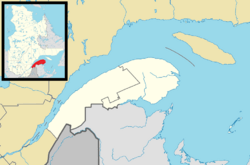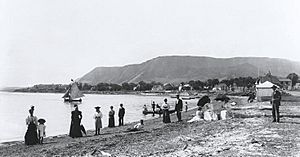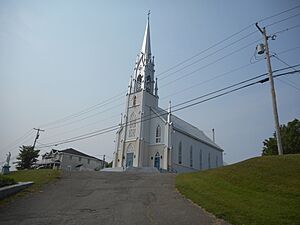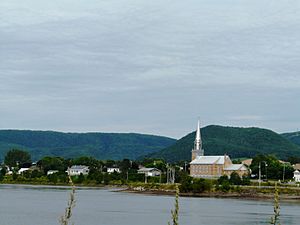Carleton-sur-Mer facts for kids
Quick facts for kids
Carleton-sur-Mer
|
|
|---|---|
|
City
|
|
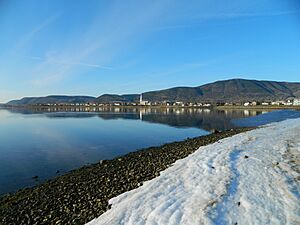 |
|
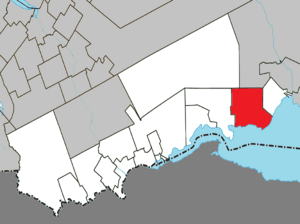
Location within Avignon RCM
|
|
| Country | Canada |
| Province | Quebec |
| Region | Gaspésie– Îles-de-la-Madeleine |
| RCM | Avignon |
| Settled | 1756 |
| Constituted | October 4, 2000 |
| Area | |
| • Total | 245.89 km2 (94.94 sq mi) |
| • Land | 221.48 km2 (85.51 sq mi) |
| Population
(2021)
|
|
| • Total | 4,081 |
| • Density | 18.4/km2 (48/sq mi) |
| • Pop (2016-21) | |
| • Dwellings | 2,222 |
| Demonyms | Carletonnais, Carletonnaise |
| Time zone | UTC−5 (EST) |
| • Summer (DST) | UTC−4 (EDT) |
| Postal code(s) |
G0C 1J0
|
| Area code(s) | 418 and 581 |
| Highways | |
Carleton-sur-Mer is a town in southeastern Quebec, Canada. It's located on Route 132, right by Chaleur Bay. It's the fifth largest town on the south shore of the Gaspésie region.
Carleton-sur-Mer is the main town for the Avignon Regional County Municipality. The town includes smaller communities like Biron, Caps-de-Maria, Carleton, Robitaille, and Saint-Omer.
Contents
History of Carleton-sur-Mer
The town of Carleton-sur-Mer was officially created on October 4, 2000. This happened when the town of Carleton and the parish of Saint-Omer joined together. At first, it was called Carleton–Saint-Omer, but in 2005, its name was changed to Carleton-sur-Mer.
Early Settlers: Acadians Arrive
Around 1756, seven families of Acadians arrived in an area called Tracadigash. They had been forced to leave their homes in Nova Scotia in 1755. Charles Dugas and Benjamin LeBlanc were among the first founders.
In 1772, Abbé Joseph-Mathurin Bourg, the first Acadian priest, came to the area. He took the first count of people in Tracadigash in 1777. He found 177 people with family names like Allard, Arseneau, Boudreau, Dugas, and LeBlanc.
Later, in 1784, a letter to the governor described how much land each family used. On average, each man had about 3 to 12 arpents of land. An arpent is an old French unit of land measurement.
Name Change to Carleton
In 1787, American Loyalists also came to Tracadigash. Because of this, the parish changed its name from Saint-Joseph de Tracadièche to Saint-Joseph de Carleton. This was done to honor General Guy Carleton.
On October 4, 2000, the towns of Carleton and Saint-Omer reunited after being separate for 100 years. The new town was first named Carleton–Saint-Omer. Then, on May 7, 2005, its name officially became Carleton-sur-Mer.
The Story of Saint-Omer
The area of Saint-Omer was part of the Parish of Saint Joseph de Tracadièche from the start. It shared a history with Carleton for many years. As more people moved west, a new parish was needed. The Parish of Saint-Omer was approved by the government in 1902.
For 100 years, Saint-Omer was its own parish and town. Its economy mainly depended on fishing, farming, and forestry. Saint-Omer had its own elementary schools. However, older students went to Carleton's high school, which is now called École Antoine-Bernard.
On October 4, 2000, Saint-Omer and Carleton joined together to form Carleton-Saint-Omer.
Saint-Louis de Gonzague Village
The small farming and forestry village of Saint-Louis de Gonzague was started in 1864. It is about 8 kilometres (5.0 mi) north of Saint-Omer. The Quebec government created it to help the economy grow.
However, the Biron section of the village was closed by the government in 1972. Only five people stayed in the village to continue farming the land.
Population and Demographics
In 2021, Carleton-sur-Mer had a population of 4,081 people. These people lived in 2,016 homes. This was a small increase of 0.2% from its population in 2016.
The town covers a land area of about 221.48 km2 (85.51 sq mi). This means there are about 18.4 people per square kilometer.
Most people in Carleton-sur-Mer speak French as their first language. About 97.2% of the population speaks French. Only a small number, about 1.2%, speak English as their first language.
Economy and Jobs
Historically, Carleton's economy was based on farming, fishing, and forest products. The town had a deep water wharf. This allowed large international ships to come and load lumber. Tourism was also important from the very beginning. People came to enjoy the beaches and warm water.
Today, tourism has grown a lot. The economy has changed, and most jobs are now in the service industry. About 74% of jobs are in this area.
The Carleton Wind Farm started working in 2008. It produces electricity for Hydro-Québec, which is Quebec's main power company.
Arts and Culture
- The high school, École Antoine Bernard, and its students were featured in a 2014 documentary film called Guidelines.
- The singer and songwriter Kevin Parent went to high school here. He sings in both English and French.
- TVA is a Canadian TV network, and CHAU-DT is its local station in the area.
Education
Carleton-sur-Mer has several schools and learning centers:
- School Board: Commission scolaire René-Lévesque. (This used to be called Commission scolaire Tracadièche, which comes from a Mi'kmaq word meaning "Place of many herons.")
- Elementary Schools: École Bourg and École des Audomarois.
- High School: École Antoine-Bernard de Carleton.
- College: Centre d'études collégiales de Carleton (part of Collège de la Gaspésie et des Îles).
- Continuing Education: Groupe Collégia.
- University: Université du Québec à Rimouski has a campus here.
See also
 In Spanish: Carleton-sur-Mer para niños
In Spanish: Carleton-sur-Mer para niños


